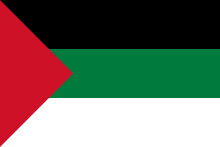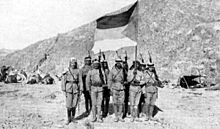Flag of the Arab Revolt: Difference between revisions
removed Category:Arab nationalism in the Ottoman Empire; added Category:Arab Revolt using HotCat |
Rescuing 1 sources and tagging 0 as dead. #IABot (v1.5.4) |
||
| Line 9: | Line 9: | ||
The flag was designed by the [[United Kingdom|British]] diplomat Sir [[Mark Sykes]], in an effort to create a feeling of "Arab-ness" in order to fuel the revolt.<ref>William Easterly, ''The White Man's Burden'' (2006), p. 295</ref> Although the Arab Revolt was only very limited in scope and concerted by the British rather than by Arabs themselves, the flag influenced the [[national flags]] of a number of emerging [[Arab World|Arab states]] after World War I. Flags inspired by that of the Arab revolt include those of [[Flag of Egypt|Egypt]], [[Flag of Jordan|Jordan]], [[Flag of Iraq|Iraq]], [[Flag of Kuwait|Kuwait]], [[Flag of Sudan|Sudan]], [[Flag of Syria|Syria]], the [[Flag of the United Arab Emirates|United Arab Emirates]], [[Flag of Yemen|Yemen]], [[Palestinian flag|Palestine]], [[Flag of Somaliland|Somaliland]], the [[Flag of Sahrawi Arab Democratic Republic|Sahrawi Arab Democratic Republic]] and [[Flag of Libya|Libya]]. |
The flag was designed by the [[United Kingdom|British]] diplomat Sir [[Mark Sykes]], in an effort to create a feeling of "Arab-ness" in order to fuel the revolt.<ref>William Easterly, ''The White Man's Burden'' (2006), p. 295</ref> Although the Arab Revolt was only very limited in scope and concerted by the British rather than by Arabs themselves, the flag influenced the [[national flags]] of a number of emerging [[Arab World|Arab states]] after World War I. Flags inspired by that of the Arab revolt include those of [[Flag of Egypt|Egypt]], [[Flag of Jordan|Jordan]], [[Flag of Iraq|Iraq]], [[Flag of Kuwait|Kuwait]], [[Flag of Sudan|Sudan]], [[Flag of Syria|Syria]], the [[Flag of the United Arab Emirates|United Arab Emirates]], [[Flag of Yemen|Yemen]], [[Palestinian flag|Palestine]], [[Flag of Somaliland|Somaliland]], the [[Flag of Sahrawi Arab Democratic Republic|Sahrawi Arab Democratic Republic]] and [[Flag of Libya|Libya]]. |
||
The horizontal colors stand for the [[Abbasid]] (black), [[Umayyad]] (white) and [[Fatimid]] (green) [[Caliphates]]. The red triangle refers to the [[Hashemite]] dynasty.<ref>Edmund Midura, [https://www.saudiaramcoworld.com/issue/197802/flags.of.the.arab.world.htm "Flags of the Arab World"], in ''Saudi Aramco World'', March/April 1978, pages 4–9</ref><ref>Mahdi Abdul-Hadi, [http://www.passia.org/palestine_facts/meaning_of_flag.htm "Palestine Facts: The Meaning of the Flag"], passia.org</ref> |
The horizontal colors stand for the [[Abbasid]] (black), [[Umayyad]] (white) and [[Fatimid]] (green) [[Caliphates]]. The red triangle refers to the [[Hashemite]] dynasty.<ref>Edmund Midura, [https://www.saudiaramcoworld.com/issue/197802/flags.of.the.arab.world.htm "Flags of the Arab World"], in ''Saudi Aramco World'', March/April 1978, pages 4–9</ref><ref>Mahdi Abdul-Hadi, [http://www.passia.org/palestine_facts/meaning_of_flag.htm "Palestine Facts: The Meaning of the Flag"] {{webarchive|url=https://web.archive.org/web/20131905305600/http://www.passia.org/palestine_facts/meaning_of_flag.htm }}, passia.org</ref> |
||
The Hashemites were allies of the British in the conflict against the Ottoman Empire. After the war ended, the Hashemites achieved or were granted rule in the [[Hejaz]] region of [[Arabia]], [[Jordan]], formally known as the ''Hashemite Kingdom of Jordan'', briefly in [[Arab Kingdom of Syria|Greater Syria]], and [[Iraq]]. |
The Hashemites were allies of the British in the conflict against the Ottoman Empire. After the war ended, the Hashemites achieved or were granted rule in the [[Hejaz]] region of [[Arabia]], [[Jordan]], formally known as the ''Hashemite Kingdom of Jordan'', briefly in [[Arab Kingdom of Syria|Greater Syria]], and [[Iraq]]. |
||
Revision as of 00:42, 2 October 2017

 Flag ratio: 2:3
Flag ratio: 2:3
The Flag of the Arab Revolt was a flag used by the Arab nationalists during the Arab Revolt against the Ottoman Empire during World War I.
History

The flag was designed by the British diplomat Sir Mark Sykes, in an effort to create a feeling of "Arab-ness" in order to fuel the revolt.[1] Although the Arab Revolt was only very limited in scope and concerted by the British rather than by Arabs themselves, the flag influenced the national flags of a number of emerging Arab states after World War I. Flags inspired by that of the Arab revolt include those of Egypt, Jordan, Iraq, Kuwait, Sudan, Syria, the United Arab Emirates, Yemen, Palestine, Somaliland, the Sahrawi Arab Democratic Republic and Libya.
The horizontal colors stand for the Abbasid (black), Umayyad (white) and Fatimid (green) Caliphates. The red triangle refers to the Hashemite dynasty.[2][3]
The Hashemites were allies of the British in the conflict against the Ottoman Empire. After the war ended, the Hashemites achieved or were granted rule in the Hejaz region of Arabia, Jordan, formally known as the Hashemite Kingdom of Jordan, briefly in Greater Syria, and Iraq.
Greater Syria was dissolved after only a few months of existence, in 1920. The Hashemites were overthrown in the Hejaz in 1925 by the House of Saud, and in Iraq in 1958 by a coup d'etat, but retained power in Jordan.
A 60 m × 30 m version of the flag currently flies from the Aqaba Flagpole, currently the sixth tallest freestanding flagpole in the world, located in Aqaba, Jordan.[4]
Description
The flag contains the four Pan-Arab colors: black, white, green and red. There are three horizontal stripes: black, green, and white, going down the flag. There is also a red triangle on the hoist side of the flag.
See also
References
- ^ William Easterly, The White Man's Burden (2006), p. 295
- ^ Edmund Midura, "Flags of the Arab World", in Saudi Aramco World, March/April 1978, pages 4–9
- ^ Mahdi Abdul-Hadi, "Palestine Facts: The Meaning of the Flag" Archived (Timestamp date invalid) at the Wayback Machine, passia.org
- ^ "The Flag of the Arab Revolt". andrewcusack.com. Retrieved 2016-10-20.
